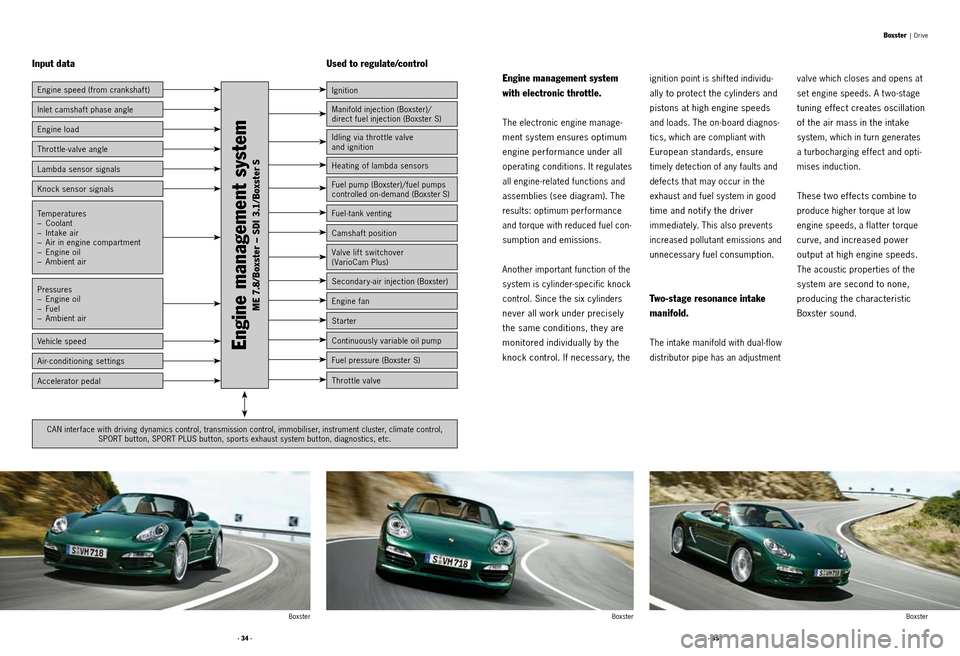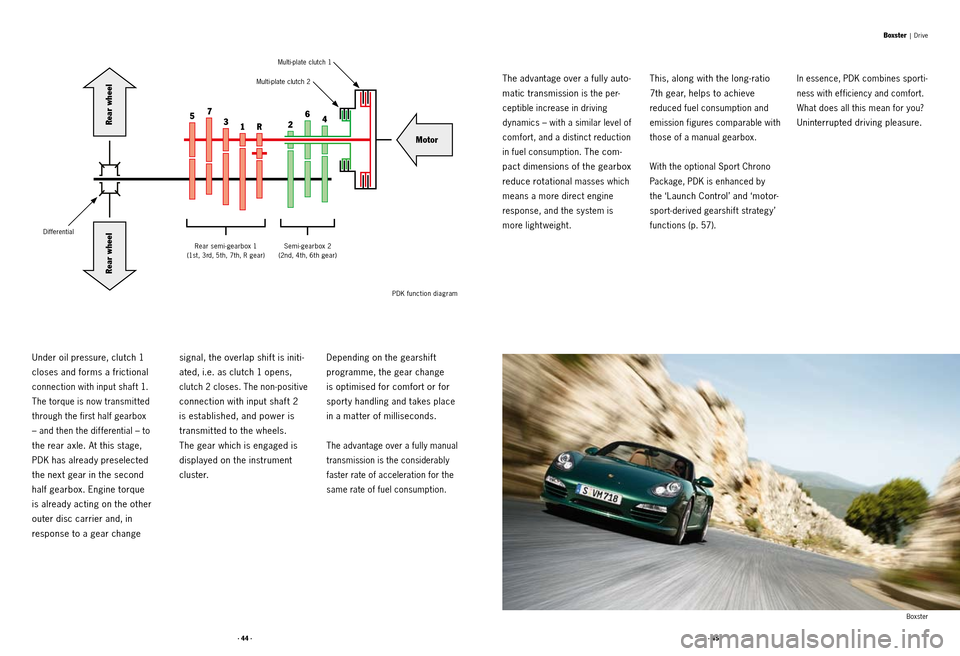diagram PORSCHE BOXSTER S 2010 2.G Information Manual
[x] Cancel search | Manufacturer: PORSCHE, Model Year: 2010, Model line: BOXSTER S, Model: PORSCHE BOXSTER S 2010 2.GPages: 62, PDF Size: 4.65 MB
Page 15 of 62

· 34 ·· 35 ·
Boxster
Boxster
Boxster
Engine management system
with electronic throttle.
The electronic engine manage -
ment system ensures optimum
engine performance under all
operating conditions. It regulates
all engine-related functions and
assemblies (see diagram). The
results: optimum performance
and torque with reduced fuel con -
sumption and emissions.
Another important function of the
system is cylinder-specific knock
control. Since the six cylinders
never all work under precisely
the same conditions, they are
monitored individually by the
knock control. If necessary, the
ignition point is shifted individu -
ally to protect the cylinders and
pistons at high engine speeds
and loads. The on-board diagnos -
tics, which are compliant with
European standards, ensure
timely detection of any faults and
defects that may occur in the
exhaust and fuel system in good
time and notify the driver
immediately. This also prevents
increased pollutant emissions
and
unnecessary fuel consumption.
Two-stage resonance intake
manifold.
The intake manifold with dual-flow
distributor pipe has an adjustment
valve which closes and opens at
set engine speeds. A t wo -stage
tuning effect creates oscillation
of the air mass in the intake
system, which in turn generates
a turbocharging effect and opti -
mises induction.
These t wo effects combine to
produce higher torque at low
engine speeds, a flat ter torque
curve, and increased power
output at high engine speeds.
The acoustic properties of the
system are second to none,
producing the characteristic
Boxster sound.
Boxster | Drive
Input data Used to regulate/control
Engine management system
ME 7.8/Boxster – SDI 3.1/Boxster S
Engine load
Lambda sensor signals
Engine speed (from crankshaft)
Inlet camshaft phase angle
Knock sensor signals
Vehicle speed
Pressures
– Engine oil
– Fuel
– Ambient air
Air-conditioning settings
Accelerator pedal
Temperatures
– Coolant
– Intake air
– Air in engine compartment
– Engine oil
– Ambient air
Ignition
Heating of lambda sensors
Fuel pump (Boxster)/fuel pumps
controlled on - demand (Boxster S)
Camshaft position
Fuel-tank venting
Engine fan
Starter
Continuously variable oil pump
Fuel pressure (Boxster S)
Throttle valve
Throt tle -valve angle
Idling via throttle valve
and ignition
Manifold injection (Boxster)/
direct fuel injection (Boxster S)
Valve lift switchover
(VarioCam Plus)
Secondary-air injection (Boxster)
CAN inter face with driving dynamics control, transmission control, immobiliser, instrument cluster, climate control,
SPORT button, SPORT PLUS button, sports exhaust system button, diagnostics, etc.
Page 20 of 62

· 44 ·· 45 ·
Under oil pressure, clutch 1
closes and forms a frictional
connection with input shaf t 1.
The torque is now transmit ted
through the first half gearbox
– and then the dif ferential – to
the rear axle. At this stage,
PDK has already preselected
the next gear in the second
half gearbox. Engine torque
is already acting on the other
outer disc carrier and, in
response to a gear change
signal, the overlap shift is initi -
ated, i.e. as clutch 1 opens,
clutch 2 closes. The non-positive
connection with input shaft 2
is
established, and power is
trans
mit ted to the wheels.
The gear which is engaged is
displayed on the instrument
cluster.
Depending on the gearshift
programme, the gear change
is optimised for comfort or for
sport y handling and takes place
in a mat ter of milliseconds.
The advantage over a fully manual
transmission is the considerably
faster rate of acceleration for the
same rate of fuel consumption.
Boxster | Drive
The advantage over a fully auto -
matic transmission
is the per -
ceptible increase in driving
dynamics – with a similar level of
comfort, and a distinct reduction
in fuel consumption.
The com -
pact dimensions of the gearbox
reduce rotational
masses which
means a more direct engine
response, and the system is
more lightweight.
PDK function diagram
This, along with the long-ratio
7th gear, helps to achieve
reduced fuel consumption and
emission figures comparable with
those of a manual gearbox.
With the optional Sport Chrono
Package, PDK is enhanced by
the
‘Launch Control’ and ‘motor-
sport- derived gearshif t strategy’
functions (p. 57). In essence, PDK combines sport
i
-
ness with efficiency and comfort.
What does all this mean for you?
Uninterrupted driving pleasure.
Multi-plate clutch 1
Multi-plate clutch 2
Semi -gearbox 2
(2nd, 4th, 6th gear)
Rear semi-gearbox 1
(1st, 3rd, 5th, 7th, R gear)
Differential
Motor
Rear wheel
Rear wheel
Boxster